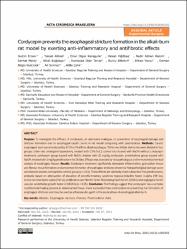Cordycepin prevents the esophageal stricture formation in the alkali-burn rat model by exerting anti-inflammatory and antifibrotic effects

View/
Access
info:eu-repo/semantics/openAccessDate
2021Author
Ercan, GülçinAltınel, Yüksel
Karagülle, Onur Olgaç
Yigitbaş, Hakan
Hacım, Nadir Adnan
Meriç, Serhat
Biltekin, Burcu
Metadata
Show full item recordCitation
Ercan, G., Altinel, Y., Karagulle, O. O., Yiğitbaş, H., Hacım, N. A., Meriç, S., Buğdaycı, N., Tartar, R. I., Biltekin, B., Yavuz, E., Gulcicek, O. B., Solmaz, A., & Çelik, A. (2021). Cordycepin prevents the esophageal stricture formation in the alkali-burn rat model by exerting anti-inflammatory and antifibrotic effects. Acta Cirúrgica Brasileira, 36(3). pp. 1-9 https://doi.org/10.1590/acb360302 Abstract
Purpose: To investigate the efficacy of cordycepin, an adenosine analogue, on prevention of esophageal damage and stricture formation due to esophageal caustic burns in rat model comparing with prednisolone. Methods: Caustic esophageal burn was introduced by 37.5% of NaOH to distal esophagus. Thirty-two Wistar albino rats were divided in four groups: sham rats undergone laparotomy, treated with 0.9% NaCl; control rats injured with NaOH without cordycepin treatment; cordycepin group injured with NaOH, treated with 20 mg/kg cordycepin; prednisolone group injured with NaOH, treated with 1 mg/kg prednisolone for 28 days. Efficacy wasassessed by histopathological and immunohistochemical analysis of esophageal tissues. Results: Cordycepin treatment significantly decreased inflammation, granulation tissue and fibrous tissue formation and prevented formation of esophageal strictures shown by histopathological damage score and stenosis indexes compared to control group (p < 0.01). These effects are relatively more substantial than prednisolone, probably based on attenuation of elevation of proinflammatory cytokines hypoxia-inducible factor 1-alpha (HIF-1 alpha), tumor necrosis factor alpha (TNF-alpha), proliferative and fibrotic factor fibroblast growth factor 2 (FGF2) and angiogenic factor vascular endothelial growth factor A (VEGFA) (p < 0.05). Conclusion: The findings suggest that cordycepin has a complex multifactorial healing process in alkali-burned tissue, more successful than prednisolone in preventing the formation of esophageal strictures and may be used as a therapeutic agent in the acute phase of esophageal alkali-burn.
















